Installation and Setup - AEM as a Cloud Service
Installation
Add S3 Bucket artifact information for Lingotek
- Create a file in your repository called
settings.xml(or modify the current one) in your AEM as a Cloud Service git repository. The path for this file should be.cloudmanager/maven/settings.xml - Add a
lingotek-aem-repowith the AWS API keys given by Lingotek. The resulting file should look something like this:<?xml version="1.0" encoding="UTF-8"?> <settings xmlns="http://maven.apache.org/SETTINGS/1.0.0" xmlns:xsi="http://www.w3.org/2001/XMLSchema-instance" xsi:schemaLocation="http://maven.apache.org/SETTINGS/1.0.0 http://maven.apache.org/xsd/settings-1.0.0.xsd"> <servers> <server> <id>lingotek-aem-repo</id> <username>AAAAAAAAAAAAAAAAAAAA</username> <!-- Lingotek given AWS API key --> <password>yyyyyFKyKokyBhSyyyoBf9RnVYPvUKkC88np5yyy</password> <!-- Lingotek given AWS API secret --> <configuration> <wagonProvider>s3</wagonProvider> </configuration> </server> </servers> </settings> In the reactor POM (the pom.xml at the root of the directory), add the following lines just before the closing
</build>tag (or add extension into existing<extensions>tag):<extensions> <extension> <groupId>com.allogy.maven.wagon</groupId> <artifactId>maven-s3-wagon</artifactId> <version>1.2.0</version> </extension> </extensions>In the same POM, add the following repository inside any profile that is activated by default (it can be added in the
adobe-publicprofile):<repository> <id>lingotek-aem-repo</id> <name>Lingotek S3 Repository</name> <url>s3://lingotek-aem-repo/release</url> <releases> <enabled>true</enabled> <updatePolicy>never</updatePolicy> </releases> <snapshots> <enabled>false</enabled> </snapshots> </repository>In the
allPOM (all/pom.xml), add the following segment inside thedependencies(substituting the correct{lingotek-version-number}):<dependency> <groupId>com.lingotek.aem.connector</groupId> <artifactId>lingotek-connector.all</artifactId> <type>zip</type> <version>{lingotek-version-number}</version> </dependency>Inside the same pom.xml (all/pom.xml), add the following snippet inside the
<embeddeds>fort thefilevault-maven-package-pluginartifact:<!-- LINGOTEK CONNECTOR --> <embedded> <groupId>com.lingotek.aem.connector</groupId> <artifactId>lingotek-connector.all</artifactId> <type>zip</type> <target>/apps/lingotek-connector/application/install</target> </embedded>- Commit all the changes to the branch and push the changes.
- The build for AEM as a Cloud Service can now be done.
Setup
Translation Cloud Services - Global
You need to set up a Lingotek Connector and Translation Integration in the Translation Cloud Services in order to use the Lingotek AEM Connector. These are AEM and Lingotek translation settings that determine how content is sent to Lingotek by AEM. You must begin by creating a Lingotek Connector and Translation Integration under your Global path under Translation Cloud Services.
Translation Connector
- Navigate to Translation Cloud Services.
- Tools > Cloud Services > Translation Cloud Services
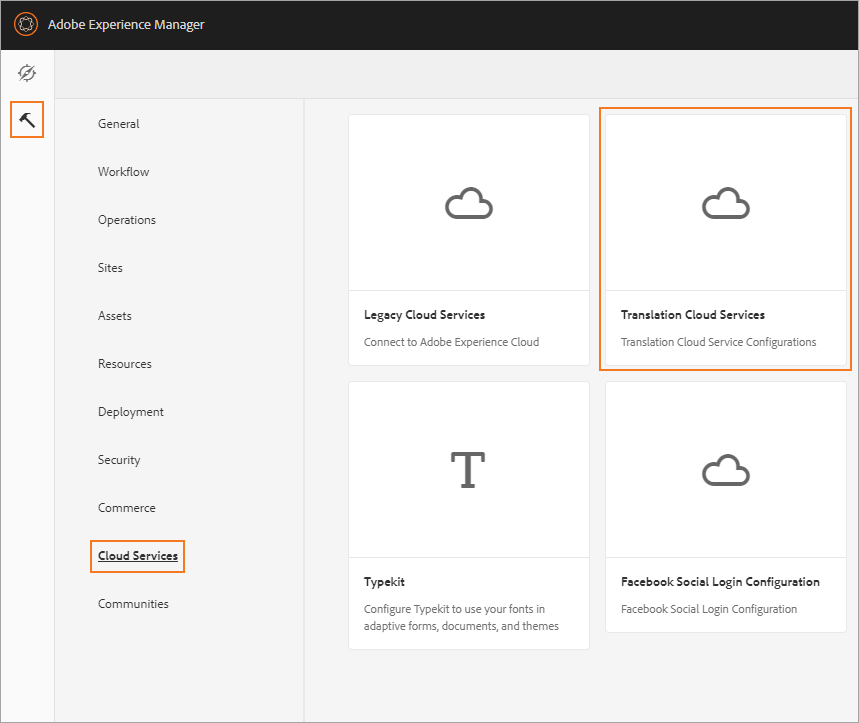
- Tools > Cloud Services > Translation Cloud Services
- Select Conf > Global > Lingotek Connector > Create

- A modal will appear where you will choose between creating a Lingotek Connector, Translation Integration, or Microsoft Translator.
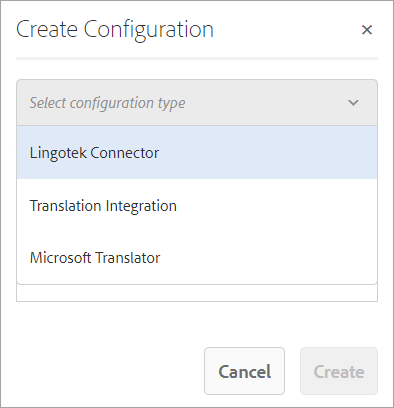
- Before setting up a Translation Integration you must set up the Lingotek Connector.
- You never need to select Microsoft Translator in order to enable Lingotek's AEM connector.
- After selecting Lingotek Connector, you will be taken to a new page where you will connect to your Lingotek Account, select a community, and choose a Translation Profile.
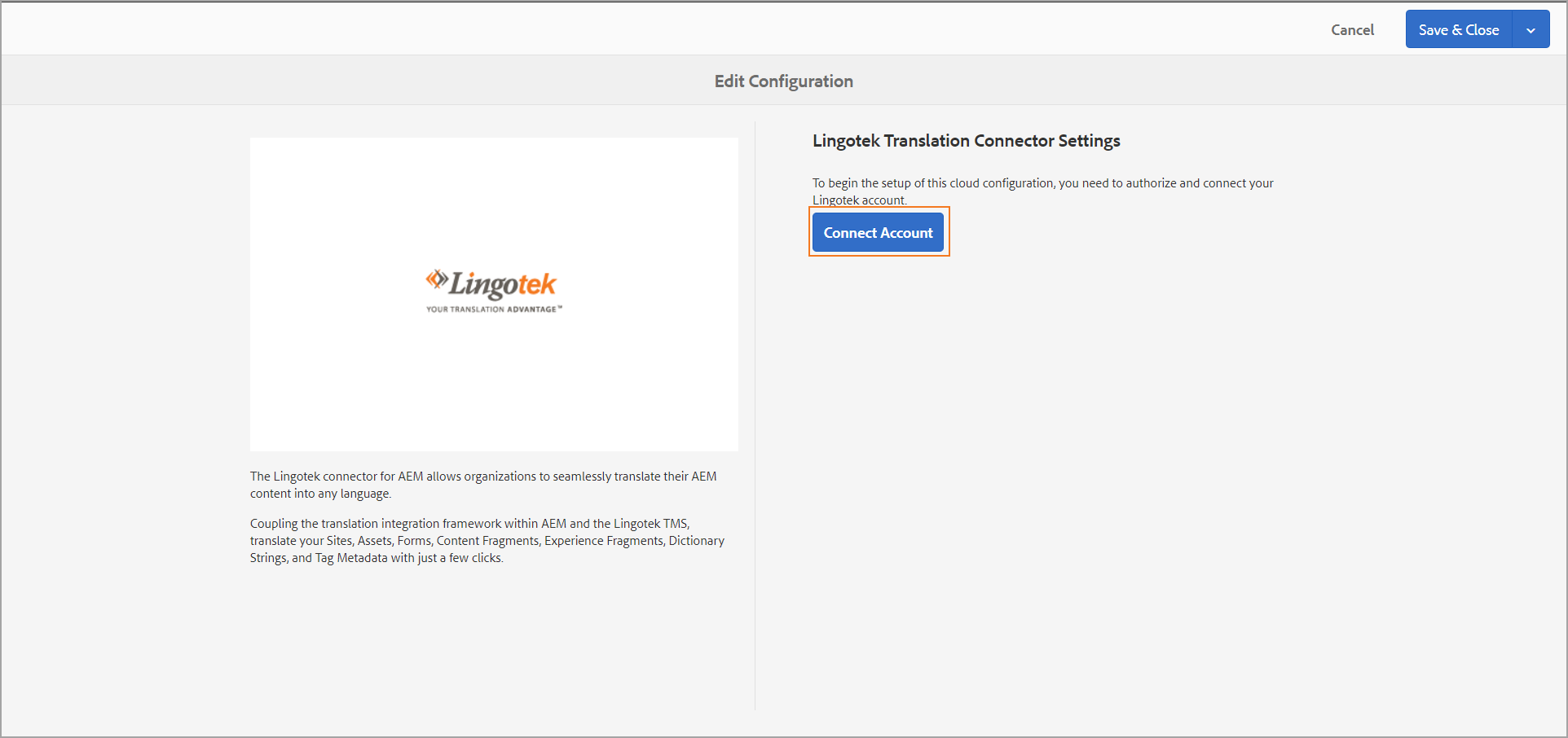
Connect Account - Select Connect Account and you will be taken to Lingotek's sign-in page. After you sign in, you will be redirected back to the previous page with new options. If you are already signed into the TMS in a separate tab in your browser, your page will simply refresh with the new option.
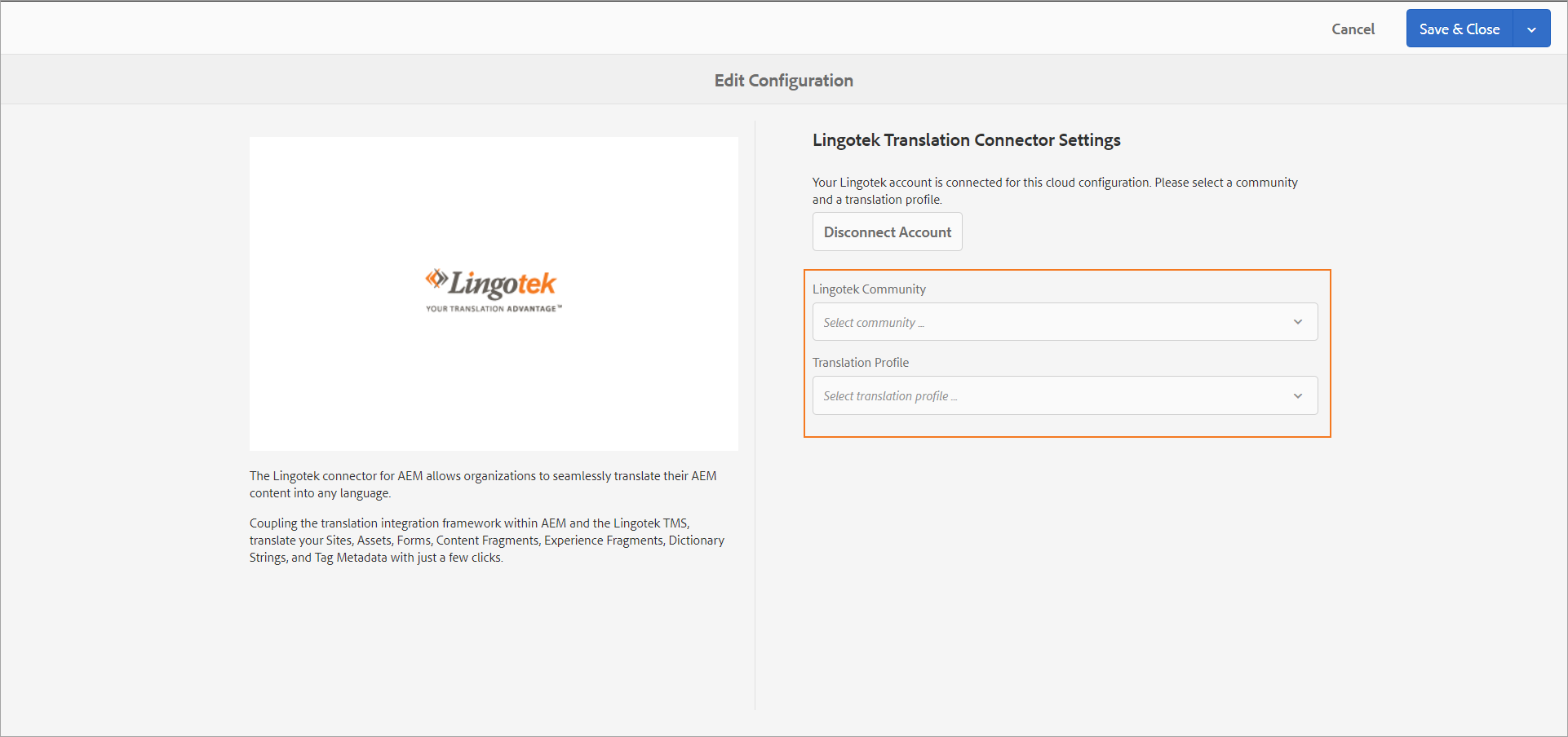
Lingotek Community - Select the Lingotek Community drop-down and choose the Lingotek Community you wish to associate with this AEM environment.
Translation Profile - The translation profile you select determines which project content will be uploaded to, the translation workflow used, and what Lingotek metadata should be attached to the uploaded content. See the Translation Profile documentation for more information. Once you have selected your Translation Profile, you will see its details appear below.
- Once you have successfully completed configuring your Lingotek Connector you can Save and Close.

- If needed, you can edit the settings in your Lingotek Connector later by selecting the Lingotek Connector and then selecting Edit.
Translation Integration
- Choose the same Global Path where you configured your Lingotek Connector and again select create.

- This time, choose Translation Integration. Lingotek Connector should not be an option. If it is, you have selected the wrong path.
- Provide a title.
- Optionally, provide a name.
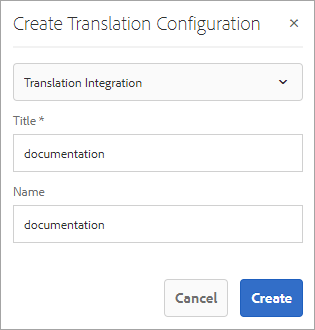
Fill out the required settings under Sites and Assets.
You will also be able to configure Communities, but those settings do not affect the Lingotek Connector, so you can leave Communites with the default settings.
- Sites
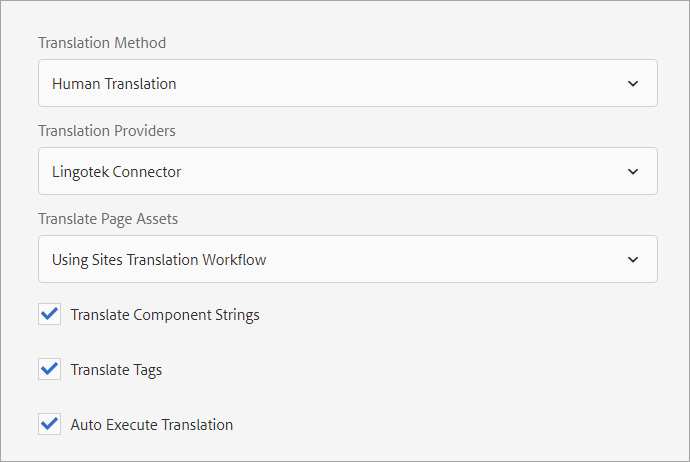
- Translation Method: Choose Human Translation for the Lingotek connector.
- Translation Providers: Lingotek if you are using our connector.
- Translate Page Assets: You have the option to use the Sites Translation Workflow for associated assets or use the asset translation workflow.
- Choose which associated content should be sent for translation and if the translation should be executed as soon as the job is created.
- Assets
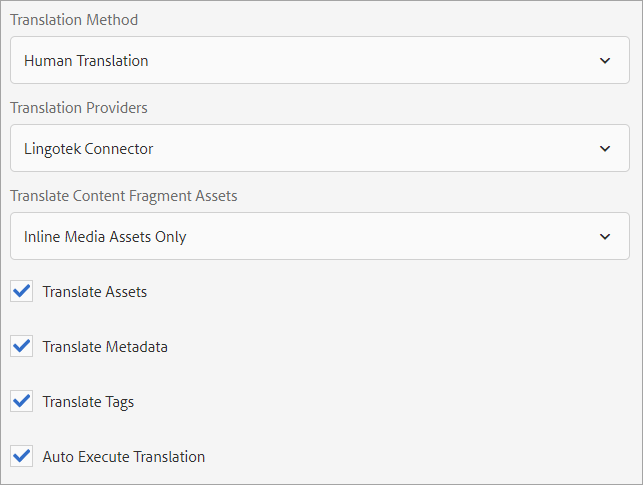
- Translation Method: Human Translation if you are using the Lingotek Connector.
- Translation Providers: Lingotek if you are using our connector.
Translate Content Fragment Assets: Choose how you want inline Media Assets and Associated Collections to be translated.
We recommend that you set this to Inline Media Assets Only.
- Choose which types of information should be sent up for translation and if the translation should be executed as soon as the job is created.
- Sites
Translation Cloud Services - Additional Site Paths
You also have the option to create Lingotek Connector settings for other Site paths under Translation Cloud configs. Please note that you should only ever create one Translation Integration under your Global path. The following documentation is for Connector settings only.
Configuring one Lingotek Connector
Configure a Lingotek Connector for the desired site path. Select the desired path, select create, and then follow the same steps described above.
- If you select this path when Applying a Translation Configuration Path (see the next section) it will use the Translation Integration settings of the Global Path with the Lingotek Connector configuration.
Configuring Multiple Lingotek Connectors
- If you do want to create multiple Lingotek Connector settings for a site path, you must first navigate to the Configuration Browser.
- Tools > General > Configuration Browser
- Tools > General > Configuration Browser
- Select the path you want to configure Lingotek Connectors and select Create.
- A modal will appear. Give the new configuration a title and select the Cloud Configuration checkbox.
Repeat this process as many times as desired in order to use multiple translation profiles so content can be uploaded to different projects, using different workflows, or tagged with unique metadata.
- Return to the Translation Cloud Services and open the path where you just created multiple Cloud Configurations.
For each newly created Cloud Configuration, configure a Lingotek Connector using the same steps described previously.
Whenever you apply a translation configuration path while creating projects, AEM will default to using the Global Translation Integration settings.
Applying a Translation Configuration Path
- When creating Translation Projects Manually, choose which Translation Config you want to use in the Advanced Settings under Cloud Configuration. See Creating Translation Projects for more information.
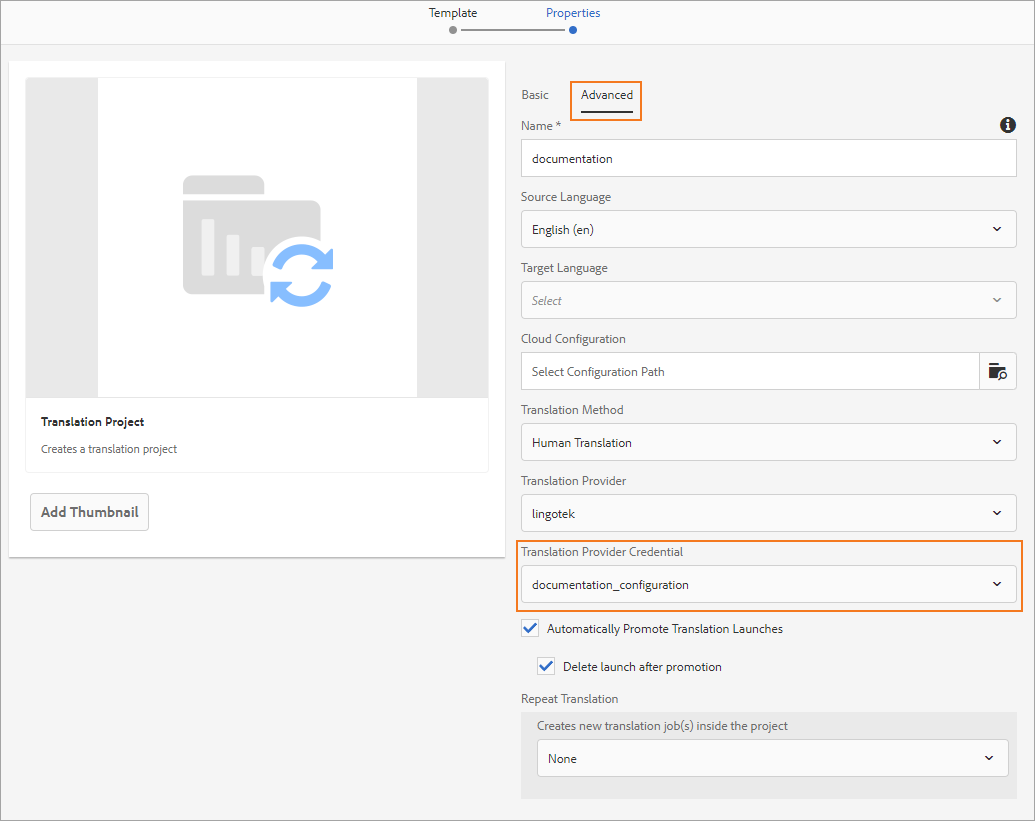
- When creating a language copy from the Sites page, you select Cloud Configuration on step 2. If you have properly set up your Lingotek Connector and your Translation Integration, all other settings will be filled out for you.
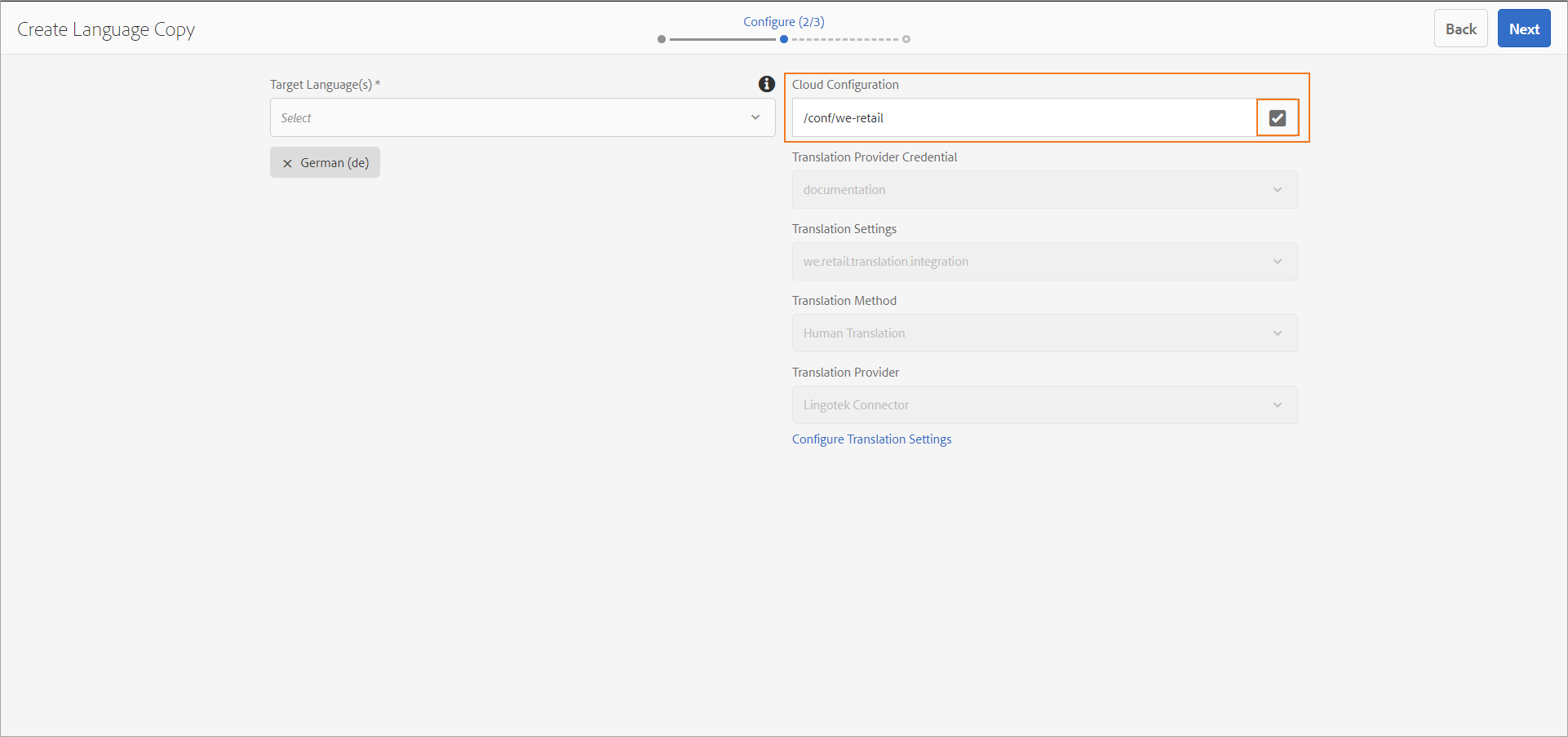
Organizing AEM Content
The Lingotek AEM connector closely follows AEM best practices. In order to correctly prepare content for translation, your source content must be organized under a single source language folder. This is a folder that is named after your source language. Note that even though AEM supports various formats, they auto-generate language copies with the <language-code>_<locale-code> format (all lowercase) so we recommend you do the same for your source language folder for simplicity.
Site Examples of a Source Language folder
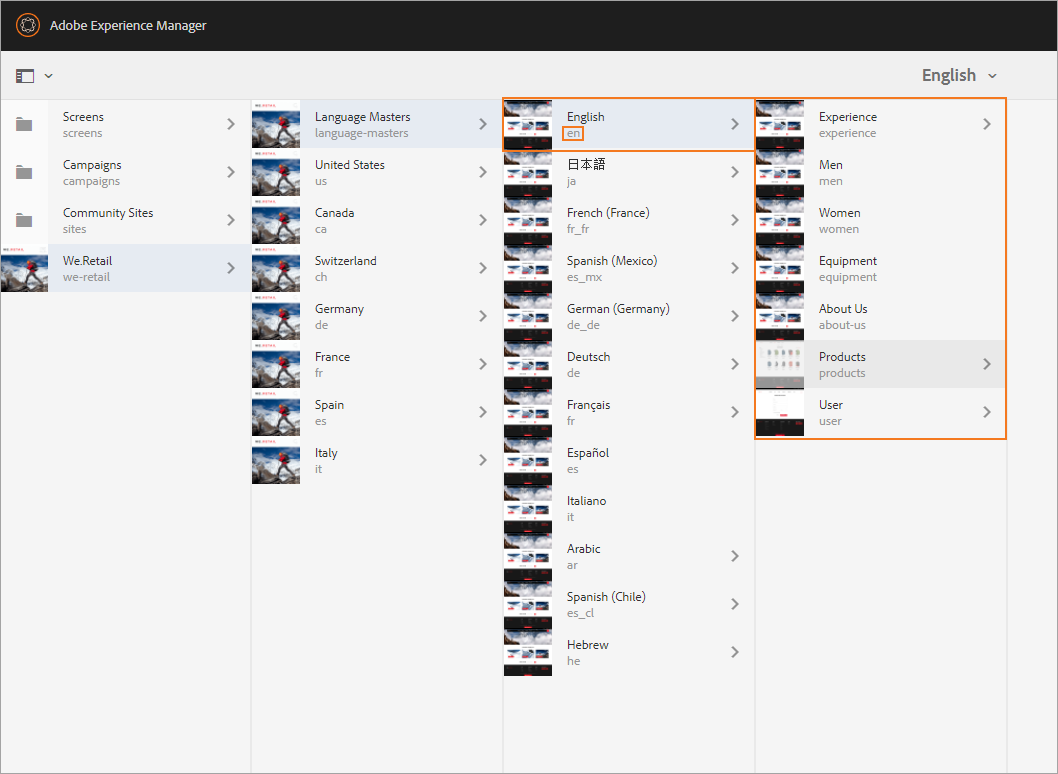
Asset Examples of a Source Language Folder
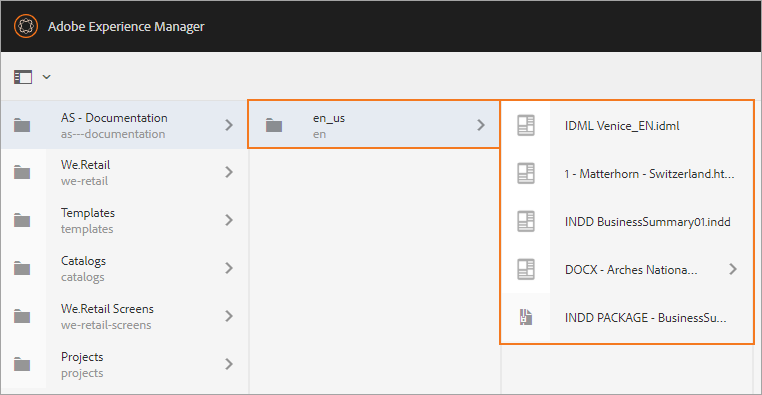
When you submit content from within the source language folder for translation a Language Copy (or several Language Copies) of the source language folder will be created named the locales of your translation.
User Permissions for In-Context Translation
Our Workbench allows linguists to translate your AEM site content in-context. You will need to give the linguists permission to view the site content for them to be able to access it in our context viewer. The simplest way to do this is outlined below:
- Create an AEM User Group with the following permissions for /content and /conf paths.
- Permission = Allow
- Privileges = jcr:read
- Create shared or unique AEM user accounts that will be given to the linguists who will be assigned to work on your AEM content.
Add those accounts to the AEM User Group.
We recommend linguists sign in to your AEM instance before getting started on their translation tasks. We support SAML 2.0 single sign-on and we have a verified integration with Okta.
On this page: